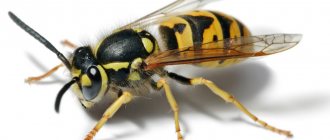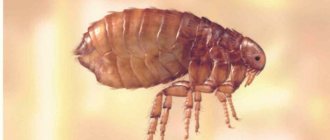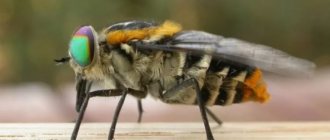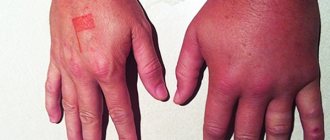Nobivac Piro and Pirodog: vaccination rules
The principle of operation of the Nobivac Piro and Pirodog vaccines is to neutralize the toxin secreted by parasites and to somewhat facilitate the process of its penetration into red blood cells.
Thus, vaccination with these drugs will not protect your pet from parasitic infection, but the disease will be much milder, and the likelihood of death will decrease significantly. The biological properties of the Pirodog and Nobivac Piro vaccines make it possible to develop immunity lasting 6 months already 14 days after administration of the drug.
The vaccine against piroplasmosis will help the dog survive the disease easier
Table: comparison of vaccine properties
Pirodog Nobivac Piro (Nobivac Piro) Biological basis of the vaccine Babesia canis antigen Babesia canis antigen in combination with Babesia rossi How to use The drug is administered subcutaneously in the withers area. One injection with one dose (1 ml) is prescribed at one time. To develop immunity, it is necessary to administer the vaccine twice with an interval of 3-4 weeks. Subcutaneous injection into the withers area. A two-time administration of the drug is necessary. Repeated vaccination is possible after 3–6 weeks Indications for the age of the vaccinated animal From 5 months From 6 months Possible side effects of vaccination Often: swelling in the injection area. Goes away without external intervention (after a few days). Rarely: lethargy and apathy (passes spontaneously), hypersensitivity to the drug (requires symptomatic treatment) Side effects are the same, but the likelihood of their occurrence is higher due to greater toxicity (the composition contains an additional Babesia antigen rossi) Use with other vaccines Possible simultaneous use with an injection of an anti-rabies drug (necessarily produced by Merial)
It is important that the injection is given in a different place. With other vaccines, the interval of use before and after should be at least two weeks. The interval of use of other vaccines before and after should be at least two weeks.
Regardless of which vaccination drug you choose, vaccination against piroplasmosis (babesiosis) should follow the following generally accepted rules:
- Before vaccination, the dog must undergo deworming (a set of therapeutic and preventive measures aimed at combating worms). It is better to do this no later than two weeks before the injection.
- Vaccination should be carried out two months before the peak of tick activity (around March). In this case, the necessary protective immunity will be developed in time, and re-vaccination will coincide with the period of the summer decline in the activity of tick attacks (this is safer).
- The dog must be healthy both at the time of vaccination and before it. The veterinarian determines the possibility of the procedure only after a comprehensive examination of the pet and ordering the necessary tests.
- The vaccine is contraindicated during pregnancy and lactation (breastfeeding).
- You should not bathe your dog for a week after vaccination. You should also forget about active physical activity for a while.
A swelling may appear at the injection site of Pirodog, which quickly disappears over time.
Factors that reduce the effectiveness of vaccination
The presence of chronic diseases in a dog can affect the effectiveness of the procedure. Especially if these are diseases associated with immunodeficiency.
The vaccine injection can be done only two months after treatment with anti-babesia drugs. In this case, before vaccination it is necessary to undergo an immunological test to exclude the presence of babesiosis.
Controversial question: is vaccination necessary?
Whether it is necessary to inject a vaccine against piroplasmosis is a controversial question. Of course, every owner strives to alleviate the condition of their pet. However, vaccination can do a disservice. The fact is that the completed vaccination “muffles” the symptoms of the disease. This means that if infected, there is a high probability of missing the initial stage of disease development. Therefore, you need to be a very attentive owner. Otherwise, assistance may be provided late. And treatment is absolutely required for piroplasmosis, regardless of whether the dog has been vaccinated or not.
So, of course, you can vaccinate your pet, but it is not a panacea. During the tick season, it is necessary to closely monitor the dog's condition and use all possible methods of protection against tick bites.
Nobivak Piro does not have medicinal properties, but it reduces the clinical manifestations of piroplasmosis
When and how to get vaccinated
Vaccination against ticks is done two months before the onset of their active period. Only healthy animals are allowed to be vaccinated!
Pirodog is vaccinated for puppies who have reached the age of five months, Nobivak - six months. Before the procedure, it is necessary to treat the worms. The dog needs antihistamines for three days after vaccination. The owner must also:
- provide the pet with enhanced nutrition and limit its physical activity;
- monitor the dog’s condition and regularly measure the temperature (it should be below 41 degrees).
If an animal has recovered from piroplasmosis, an anti-tick vaccination is given two weeks after recovery!
The injection can be done personally or at the veterinary clinic. The drug can be purchased in advance or on the spot. On average, the price of Pirodog is 2447 rubles, Nobivac - from 257 to 450 rubles.
Repeated vaccination is carried out after 3-6 weeks. The validity period of the “control” dose is 6 months. To avoid infection with babesiosis, it is recommended to vaccinate your dog every six months (not more often!).
Treatment for fleas and helminths is usually carried out before vaccination. If for some reason the owner did not do this, it is recommended to wait 2-4 weeks after administering the vaccine and only then apply drops to the withers.
Contraindications
It is not recommended to give your dog several types of vaccines at once. The exception is complex vaccinations. Also, Nobivak and Pirodog are incompatible with antibiotics and sulfonamides. These drugs are contraindicated in patients undergoing rehabilitation after illness and in nursing dogs.
Nobivak and Pirodog have been tested repeatedly. The study results did not reveal any side effects. A few individuals had swelling at the injection site and a slightly elevated temperature.
Before giving an injection, you must consult your doctor! He will analyze the dog’s condition and express his opinion on the need for vaccination.
The effectiveness of tick vaccination is still controversial. According to medical research, 80% of dogs have become resistant to the virus. The best way out of the situation is preventive measures. Drops on the withers and an anti-tick collar will protect the dog from the invasion of parasites.
Pros and cons of serum
In dogs vaccinated against the consequences of tick bites, emerging infectious diseases are much milder or completely asymptomatic. In addition, they help prevent the severe consequences of babesiosis (encephalitis).
There are also disadvantages to such vaccinations. Some experts question their effectiveness, since the immune system plays a secondary role when infected with piroplasmosis. The protective functions of the body in this case help reduce the dangerous effects of toxins released by blood parasites.
Among other disadvantages is the high price of drugs. Vaccinating a dog against ticks costs on average 2,500 rubles, excluding the injection by a veterinarian.
Despite this, some experts argue that vaccination is necessary because it reduces the risk of developing encephalitis. Vaccinations are especially necessary for animals living in unfavorable areas where there is a high risk of contracting babesiosis.
Vaccination scheme for dogs against ticks and fleas
There are several types of vaccinations that determine the schedule, or schedule, for vaccination. As a rule, there are few differences.
The first vaccination is given when the puppy reaches 5-6 months of age. In the future, the procedure is usually repeated every year.
| Vaccination services | Price |
| Domestic vaccine | from 1200 rub |
| Imported vaccine (complex) | from 2000 rub |
| Rabies | from 1000 rub |
| Leptospirosis | from 1000 rub |
| Microsporia and trichophytosis (lichen) | from 1000 rub |
| Piroplasmosis | from 3000 rub |
| Passport registration | 500 rub |
To obtain the necessary additional information about vaccinating dogs against fleas and ticks, you can call us and ask any questions. Our specialists work in Moscow and the Moscow region and visit your home at a time convenient for you. you don’t have to go to the veterinary clinic and expose the animal to unnecessary stress.
Tick vaccination for dogs: how and when to do it
Vaccination is an effective protection against many diseases not only for humans, but also for dogs. How effective and reliable is the tick-borne encephalitis vaccine for dogs, and in what situations should it be given? In this article we will look at these questions.
Do dogs get tick vaccinations?
Encephalitis is one of the very dangerous diseases that leads to serious problems with the health of the animal, and if not treated in a timely manner, to death. Not long ago, a vaccine against this disease was registered in our country, but it is not included in the mandatory vaccination program. Thus, the dog can be vaccinated against this disease, but before subjecting your pet to this procedure, it is better to clarify some issues for yourself.
Many people call this drug a “tick vaccine,” but this definition is not entirely accurate. Vaccination cannot prevent tick bites, and does not even provide a 100% guarantee that your dog will not become infected.
A weakened virus is introduced into the animal’s body, which activates the production of antibodies, so that the body can more effectively fight the infection when it enters the body.
Thus, even after vaccination, the animal will most likely develop encephalitis, but the course of the disease will be milder and less life-threatening. This state of affairs has not only advantages, but also disadvantages.
The fact is that a weakened course of the disease can lead to the owner not noticing the symptoms of encephalitis in his animal for a long time, while the virus multiplies in the blood. This will lead to the fact that treatment will not be started in a timely manner, which can lead to further complications for the dog’s body.
How and when to vaccinate a dog against ticks?
Vaccination is carried out only for healthy dogs. To prevent allergies, the dog should not be bathed after vaccination.
Also, tick vaccination for dogs requires compliance with standard precautions:
- The dog must take antihistamines for 3 days before/after vaccination.
- The animal needs to be provided with an optimal diet and rest.
- Inspections and temperature control measurements are carried out.
- You cannot carry out several vaccinations within a month.
- Vaccination against tick-borne encephalitis in dogs can be carried out only after reaching 5 months of age. About a month after vaccination, it is necessary to undergo revaccination to create primary immunity. On average, the vaccine provides protection against encephalitis for 6 months.
Important! Vaccination does not provide complete protection against infection; its effectiveness usually does not exceed 75-80%. It is recommended to carry out the procedure before the start of the tick activity season, approximately 1.5-2 months.
In this case, the animal will already have time to develop immunity, and revaccination will be needed just during the summer decline in parasite activity.
It is recommended to carry out the procedure before the start of the tick activity season, approximately 1.5-2 months. In this case, the animal will already have time to develop immunity, and revaccination will be needed just during the summer decline in parasite activity.
Vaccination against encephalitis for dogs can only be carried out by a veterinarian, after a thorough examination and receipt of test results for the dog.
A slight swelling may form at the injection site, which will disappear in a couple of days, and minor side effects are possible - lethargy, loss of appetite.
The vaccine does not prevent infection, so its use does not cancel seasonal treatments against ticks! The main thing is to maintain a time interval of several days between these procedures.
Tick vaccine for dogs: contraindications
- Vaccination is not given to pregnant and lactating dogs.
- It is not allowed to mix the substance with other vaccines. Other vaccinations can be carried out 2-3 weeks apart, before or after the encephalitis vaccination.
- If an animal has had encephalitis, vaccination can be carried out 2 months after the onset of the disease. Also, vaccine manufacturers indicate that the effectiveness of the vaccine in this case may be reduced.
Are there any anti-tick vaccinations for dogs?
Piroplasmosis
The most common consequence of a tick bite in dogs is piroplasmosis, which is initiated by microscopic protozoa (pyroplasmas) that parasitize the red blood cells of the host animal.
The synonymous name for piroplasmosis is babesiosis, since the Latin name of the pathogen is Babesia canis. The course of the disease is usually acute and severe, accompanied by damage to the liver, spleen, kidneys and, without treatment, ending in the death of the dog within 3-7 days. The main symptoms are:
- severe weakness;
- refusal of food;
- unsteady gait;
- temperature rise above 39.5°C;
- On the 2nd-3rd day of the disease, yellowness of the mucous membranes and bloody or dark brown coloring of the urine are noted.
A reliable diagnostic method is a blood smear and microscopic detection of Babesia in red blood cells.
Currently, the following vaccines against piroplasmosis for dogs are presented on the veterinary drug market:
- Nobivac-Piro (Netherlands), bivalent, contains soluble antigens from 2 weakened strains: Babesia A and Babesia rossi;
- Pirodog (France), monovalent, made from gamma-ray-treated red blood cells of laboratory dogs infected with Babesia canis;
- Eurican Piro (France) is similar to Pirodog.
A preventive injection against piroplasmosis for dogs is given subcutaneously, starting at 6 months of age, and after 3-6 weeks a revaccination is given with a second dose. Vaccination against piroplasmosis for dogs should be repeated at intervals of 6 months (in winter and summer) when living in an area unfavorable for this disease.
It should be noted that the drug does not have a therapeutic effect, and therefore is not a life-saving injection for a dog after a tick bite, since the immune response is formed only a few weeks after revaccination, and the destructive effect of intracellular blood parasites on the body begins a few days after they enter the body. blood. Thus, it is prohibited to give a vaccine to a dog after a tick bite.
Animals with clinical manifestations of piroplasmosis and those in a latent form of the disease are given appropriate treatment, and immunization - no earlier than 2 months after recovery. To quickly stop the attack of piroplasms, other drugs are used - “Piro-stop”, “Azidin” and their analogues.
The low popularity of vaccines against piroplasmosis among consumers is explained by their high cost (the cost of 1 dose of the drug averages $40) and low effectiveness. According to the observations of practicing veterinarians, a number of vaccinated dogs, after being bitten by an infected tick without timely specific treatment, develop a chronic form of piroplasmosis, lasting 3-6 or more weeks. Slow recovery occurs if the dog’s immunity is strong, and the organs are not undermined by physiological imbalance or old age, while harm to the body will undoubtedly be caused. The body of older and weakened animals may not be able to cope with such a serious test, and the owner, due to inexperience or inattention, often misses vague symptoms, realizing it too late.
Why does this happen, despite the official promises of manufacturing companies? The fact is that all vaccines against canine babesiosis contain two types of antigens: somatic (contained on the shell of the piroplasms themselves) and soluble parasitic antigens (SPA), which arise from the breakdown of the red blood cells of the host animal. The pathological effect of RPA causes an increase in the permeability of blood vessels, destruction (hemolysis) and aggregation (sticking together) of red blood cells with subsequent thrombosis.
After vaccination, the dog’s body produces protective antibodies. But antibodies to somatic antigens are useless, since Babesia are intracellular parasites: the immune complex cannot penetrate into red blood cells. Antibodies initiated by immunization neutralize for the most part only RPA, which explains the milder course of the disease in vaccinated dogs. Thus, the vaccine against piroplasmosis is not aimed at destroying Babesia, but only at smoothing out symptoms by neutralizing parasitic antigens that arise as a result of the life of Babesia in the dog’s body.
Lyme disease
Lyme disease, or borreliosis, is also initiated by the bite of an ixodid tick, which transmits bacteria of the genus Borrelia to the host animal. Doctors classify borreliosis as a nonspecific zoonotic infection, also found in cats, horses, sheep, deer and humans. In 80% of dogs, the disease occurs without obvious clinical signs. In addition to lethargy and poor appetite, you may experience:
- intermittent claudication resembling arthritis, with swelling and increased local temperature in the joint area;
- skin erythema and enlarged lymph nodes;
- development of cardiac pathologies (arrhythmia, extrasystole, chronic heart failure, conduction block);
- neurological symptoms (neuritis, asymmetric paralysis of the limbs, muscles of the head and trunk, ataxia, convulsions, obsessive movements);
- glomerulonephritis and renal failure phenomena.
The disease lasts for months, exhausting the body and masquerading as other ailments. Lyme disease can be difficult to diagnose. To do this, use the microscopic method, sowing the pathogen in a nutrient medium, as well as serological tests IIF and Elisa. Treatment comes down to administering doses of antibiotics from the penicillin, tetracycline or macrolide group.
As a specific prevention in Western countries, a dog is vaccinated against borreliosis with one of the following vaccines:
- Recombitek Lyme (Merial, France);
- Lymevax (Fort Dodge Animal Health, USA);
- Galaxy Lyme (Shering-Plough, Belgium);
- Borrelym 3 (Bioveta, Czech Republic);
- Duramune Lyme (Fort Dodge Animal Health, USA);
- Nobivac Lyme (Intervet Schering-Plough Animal Health, The Netherlands);
- Vanguard crLyme (Pfizer, USA).
Lyme disease vaccines can be monovalent or bivalent, and with or without adjuvants to stimulate an immune response. In the CIS, such drugs are considered new and do not yet have mass demand.
The primary vaccine is given to puppies at 3 months with a booster vaccination after 2-3 weeks. The recommended period for immunization is November-March, before the seasonal appearance of ticks. To create lasting immunity, annual revaccination is carried out.
Tick-borne encephalitis
Another dangerous disease carried by ticks is tick-borne encephalitis. Its causative agent is a flavivirus, which includes three genotypes (Far Eastern, European/Western and Siberian), each of which produces its own symptoms and nature of damage.
Given the severity of the disease, dog owners should be aware of its symptoms and protective measures, including having their dog vaccinated against tick-borne encephalitis.
The incubation period of infection is 1-2 weeks, in puppies it is several days. The virus, which enters the bloodstream with the tick's saliva, enters the intercellular space, and then through the lymph flow into the lymph nodes, liver and spleen. Motor neurons of the spinal cord of the cervical region are also affected, and through them - the cerebellum and meninges. As the disease progresses, the following symptoms are recorded:
- fever;
- apathy or increased excitability to the point of aggressiveness;
- decreased appetite;
- violation of coordination of movements;
- accommodation disorder and the occurrence of strabismus;
- laryngeal muscle spasm, hoarseness;
- innervation disorders, muscle paresis;
- muscle tremors, cramps.
Vaccination against piroplasmosis - should I do it?
Perhaps the most pressing issue of all, because the world is divided into “for” and “against”. And the disease itself does not need too much introduction. Remember, piroplasmosis or babesiosis is the most common disease in dogs, transmitted by ixodid ticks. And one of the most dangerous, since without treatment it has a 100% mortality rate.
Piroplasmosis can kill a pet even in a few days in certain circumstances
That is why it is so important to strengthen the dog’s body in advance in the spring, in order to have the time required for a timely reaction and coping with a dangerous illness.
The essence of the disease is the damage and destruction of red blood cells in the dog’s blood, which leads to damage to some organs and vital systems of the body.
Remember safety measures during a dangerous period!
Typically, when a disease occurs, an animal will experience the following symptoms:
- lethargy and apathy of the animal;
- very dark urine, even black;
- the occurrence of jaundice as a consequence of liver damage;
- temperature increase;
- heart problems;
- impaired coordination of movements.
It should be said right away that this disease is so tenacious that even vaccination does not provide any guarantee of preventing infection. However, the babesiosis vaccine should not be written off.
Even if a vaccine is sometimes unable to completely protect an animal from a disease, in our humble opinion, such a vaccination is still necessary. In any case, the vaccine mobilizes the dog’s immunity as much as possible.
As a result, we will not get an acute form of the disease, which can quickly put your dog on its back, but a chronic form, which can be easily managed with timely treatment and, ultimately, put your dog back on his feet. In a word, the vaccine gives us time to maneuver.
Vaccines
Three complex drugs have been registered in Russia that can protect domestic animals from the consequences of a tick bite.
The following vaccines are currently considered effective:
- Nobivak Piro is a Dutch drug produced by Intervet. The vaccine contains strains of pathogenic bacteria Babesia A and Babesia rossi. After administration of the drug, an immune response to the activity of pathogenic microorganisms is developed.
- Pirodog is a vaccine produced by the French pharmacological company Merial. The drug is effective against piroplasmosis (babesiosis). Immunity is developed 14 days after the vaccine is administered and lasts for six months.
- Eurikan Piro is a drug similar in action to Pirodog. There is no allergic reaction after administration of the vaccine. It is rare to observe loss of appetite and lethargy in your pet. Symptoms go away on their own within 2 days.
Description of Pirodog
The Pirodog vaccine is made from red blood cells of SPF dogs that are infected with the parasite Babesia canis (strain BC15-19) and treated with gamma rays with a dose of at least 25 kGy.
The diluent is made from saponin and diluted with water for injection. In appearance, Pirodog is a dry, homogeneous mass of dark pink color; diluent - a clear, colorless liquid. Pharmacological properties:
The Pirodog vaccine causes the formation of an immune response in dogs to the causative agent of babesiosis after 14 days, lasting 6 months after a single injection and at least 12 months after a double injection. 1 dose (1 ml) of the Pirodog vaccine contains Babesia canis antigens in an amount that is sufficient for the formation of antibodies in the body of vaccinated dogs in a titer of at least 2.2log10. The Pirodog vaccine is harmless and has no medicinal properties.
Indications:
The Pirodog vaccine is prescribed for the prevention of piroplasmosis (babesiosis) in dogs.
Consequences and symptoms of tick bites for dogs
As a result of a bite, a pet can become infected with dangerous diseases, here are some of them:
- PYROPLASMOSIS. The most common disease in dogs that is transmitted by ticks. Accompanied by high temperature and an extremely negative effect on the heart, gastrointestinal tract, and other internal organs.
- BORRELIOSIS. Apathy, cardiac dysfunction, inflammation of joints and blood vessels are just some of the signs of borreliosis. The disease is dangerous for people.
- HEPATOZOONOSIS. Infection manifests itself against the background of reduced immunity, even after several years. Symptoms include fever, joint and muscle pain, weakness, and discharge from the eyes.
- ENCEPHALITIS. A disease that affects the brain of an animal and manifests itself poorly in the early stages. As in all previous cases, the risk of death is high, so prompt intervention by experienced veterinarians is required.
Since the risks are very high, owners should protect their pets and family members from the listed diseases. Therefore, vaccinating a dog against a tick bite is one of the available measures that must be taken.
Vaccination against encephalitis
Tick-borne encephalitis is a focal viral infection transmitted by ticks.
Even in the forest plantations closest to the city, in open natural areas, every person has a high chance of catching encephalitis during the season. To reduce this likelihood, it is necessary to undergo the vaccination procedure on time. Vaccination against tick-borne encephalitis can be done in our specialized clinic “Child”. The medical center’s specialists are highly qualified and offer the most effective means for developing immunity against a dangerous disease. We have been vaccinating children for many years and have everything necessary to provide quality medical care. In addition, our center has the most loyal pricing policy, which you can verify by visiting the clinic in person or by reading the price list on the website.
Specific means
Pyro-Stop. In fact, this medicine can be considered a complete analogue of the same Imidosan, and therefore it has all the strengths and weaknesses of the latter, including the above-mentioned nuances. The administration of the drug is also accompanied by a strong pain reaction. The only difference is the dosage (also 0.5 ml, but for every 10 kg of live weight).
Hemosporidine. Dose – up to 0.8 ml per kilogram of live weight. The drug helps the body of sick animals cope with the severe consequences of blood-parasitic diseases, or rather, it normalizes the disrupted functioning of the hematopoietic system of their body.
Antibiotics of the tetracycline group. Especially doxycycline. These are the only nonspecific drugs to the presence of which blood parasites react quite nervously. There is, however, a downside - even with not too long-term use, these drugs can easily lead to kidney and/or liver failure. In addition, they have a very bad effect on the hematopoietic system of dogs. They are used only under the constant supervision of a veterinarian! It is strongly recommended to administer the same Doxycycline in several places, splitting the dose.
Hepatoprotectors
This is the name of drugs that protect the animal’s liver and accelerate regeneration processes in its parenchyma. We have repeatedly emphasized that all specific agents used to destroy, for example, piroplasms, are extremely toxic. Therefore, the use of hepatoprotectors is a vital necessity:
Heptral. One of the hepatoprotectors with clinically proven effectiveness. For example, the well-known Essentiale Forte and all its analogues are not recognized by the international medical and veterinary communities. The maximum daily dose is 800 mg, but the desired dose is no more than 400 mg.
Laennec. Let us immediately note that it is rarely used in veterinary medicine (due to its not the most “humane” cost). But at the same time the drug is really good. Administer up to 2 ml per day. Since the medicine contains hydrolyzed placenta, allergic reactions are possible.
Remaxol. Contains succinic acid, which has a general strengthening effect on the liver. It also stimulates regeneration. Should only be administered intravenously. The maximum daily dose is 150 ml; the rate of administration should not be increased above three milliliters per minute.
Essentiale-N for intravenous administration. Up to four ampoules per day. Intramuscular administration is acceptable, but extremely undesirable (an inflammatory reaction may develop).
Drugs for detoxication
Their purpose is easy to guess. The following drugs are most often used in veterinary medicine:
- Regular glucose solution. The dosage depends on the concentration.
- Saline. The daily dose (depending on the weight of the dog) can reach two liters or more.
- Ringer's and Ringer-Lock's solution. Up to 1.5 liters per day.
- Hemodez. One of the best drugs used for intoxication caused by blood parasitic infections. Administer from 50 to 200 ml per day.
- Reamberin. Quickly relieves intoxication, alleviates the condition of the liver and kidneys. Daily dose – up to 70 ml.
Forms and symptoms of demodicosis
Typical signs of acariasis in dogs are alopecia - hair loss in certain areas. Itching appears when demodicosis is accompanied by a bacterial infection. Features of the clinical manifestations of this disease depend on its form. There are localized, generalized and juvenile demodicosis.
Localized (focal) form
― the easiest, in most cases not requiring special treatment, except for taking general strengthening agents and immunomodulators. Focal demodicosis manifests itself in the form of several small bald spots on the coat, most often they are located on the head, chest or stomach of the dog. The skin in the affected area may be inflamed and flaky. The disease usually goes away on its own within 1-3 months.
Generalized form.
Colonies of mites occupy large areas of the skin, and if left untreated, penetrate into internal organs, having a destructive effect on them. It is difficult to cure the generalized form, since the immune system of a sick animal is not able to provide adequate resistance to the “aggressor”.
Generalized demodicosis is characterized by the formation of vesicular or purulent, foul-smelling rashes, inflamed, reddish-purple skin, hyperkeratosis (thickening of the stratum corneum of the dermis). Due to damage to the internal organs, the dog may experience drooling, vomiting, dyspepsia, exhaustion, and convulsions. Therapy for this type of disease can take up to six months, and improper treatment or lack thereof can lead to death.
Juvenile form
The disease is diagnosed, as a rule, in puppies up to two years of age. The affected areas in this form are localized on the paws (pododemodecosis), ears (otodemodecosis) and around the eyes (the dog develops spectacle-shaped bald spots). With good immunity, the disease goes away on its own after a couple of months, otherwise juvenile demodicosis transforms into a focal or generalized form.
Tick vaccination for dogs
Hello. My dog was vaccinated against ticks at the withers, it was unsuccessful, and now a pouch has appeared under the skin. What should I do? Lyuba
Hello, Lyuba!
A good owner undoubtedly cares about his animal. We often experience a dog’s illness as if it were our own or our child’s.
Every year, with the approach of that dangerous season when ticks become more active, dog breeders begin to worry about how to protect their pet from this scourge. Many people believe that it is enough to get vaccinated and that’s the end of the matter, but this is not entirely true. In fact, there is actually no vaccine that will protect your animal from this parasite. Many of the vaccinations begin to work only after 2 weeks. after a second injection with an interval between procedures of 3–4 weeks. During this period, the animal can become infected more than once. The vaccine only reduces the severity of the disease. Hence the question: is there any point in vaccination?
Prevention of piroplasmosis
In fact, there is a way out. There are products available to treat your friend's skin against parasites. These can be drops, special collars, shampoos, lotions, aerosols, sprays or powders. The market for these drugs is constantly expanding. The most common are drops. They are applied to the dog's skin between the shoulder blades and above. Follow the instructions carefully. If the packaging says that the drops are effective for 4 weeks, then re-application must be done exactly on time. The pipette for application should be purchased strictly according to the weight of the dog. 3 days before applying the drug, you cannot bathe the animal, as well as after 3 days.
The sprays last for almost a month, they are also easy to apply and give positive results. If your dog is carrying puppies, carefully read the contraindications on the packaging. Not all sprays are suitable for adult dogs, and not all are suitable for puppies. Consult your pharmacy. Spray should be applied against the fur, avoiding contact with eyes, nose and mouth. The vapors of the medicine are toxic, so it is better to spray the dog in the air. Distract the animal after treatment so that it does not have time to lick the drug, and do not let other animals do this.
The main thing is that from the moment of the first thaw until the first frost sets in, your dog is reliably protected. After each walk, inspect it, don’t be lazy.
If you suspect that an animal is infected, the first thing you will be advised to do is take a blood test. It is worth insisting that a blood test be taken in two different places, because a tick bite does not immediately make itself felt, and the infection does not spread quickly.
Observation after vaccination
If you decide to get vaccinated against ticks, you may have encountered the fact that it left a ball under the skin. There may be several options. The first is that an abscess has appeared, which will ultimately require surgical intervention. The second option: the drug under the skin will soon dissolve, and this problem will disappear by itself. In the third case, most likely, this is an infiltrate after vaccination, which is not at all dangerous, but can remain on the animal’s skin for several months
The most important thing in such a situation is to closely monitor the animal. If the lump grows, itches or hurts, go to the hospital immediately
In the neck area, drugs are not absorbed very well, and this happens often. Perhaps this is an individual intolerance to the drug by your pet. Then next time choose a different composition of the drug and a different injection site.
As written above, vaccination will not save your dog from being bitten, but you can save it. Try to take your dog for walks where there are fewer trees. Of course, walks in shady, cool places are much more pleasant, but your animal will be safe, and this is much more important.
If your dog is bitten by a tick, do not panic. Infection does not occur at the same moment as the bite. The female, having drunk blood, only then releases it back, and then infection occurs. So you have almost 24 hours to take action.
Follow all the rules of hygiene, and you and your pet will be happy.
Helpful advice?
Contraindications for vaccination
Are dogs vaccinated against ticks if the female is pregnant or nursing puppies? Veterinarians strictly prohibit vaccinating dogs during this period. To protect your pet, all vaccines must be given before pregnancy. Vaccination of a dog after a tick bite should only be carried out by a qualified veterinarian.
Any drug against babesiosis has contraindications for vaccination. It is prohibited to use these solutions together with other solutions that form immunity in dogs against viral infections (Nobivak DHPPI, Multikan, etc.). The combined use of Pirodog and Eurikan Piro with drugs that protect the animal from leptospirosis and rabies is allowed, however, all solutions must be administered in different places. If a pet is vaccinated with Nobivak Piro, at least 2 weeks must pass before and after immunization with other vaccines.
The babesiosis vaccine does not protect pets from tick bites. Veterinarians note that dogs who have been injected with the drug tolerate piroplasmosis much easier. Vaccination should be carried out strictly in a veterinary clinic under the constant supervision of a doctor.
How does vaccinating dogs against fleas and ticks work?
It should be understood that vaccinations cannot protect against bites. But they reduce the dangers associated with infection that can occur as a result of contact with the parasite. Vaccination does not provide a 100% guarantee, but it prevents complications and serious consequences for the dog’s body. If the animal has been vaccinated, its immunity will be ready to fight infection. The likelihood of death is minimized, and recovery occurs much faster.
To enhance protection, you can choose a comprehensive type of prevention. In addition to tick vaccinations, it is useful to use serum for encephalitis (or other similar infection) and flea and tick repellent.










